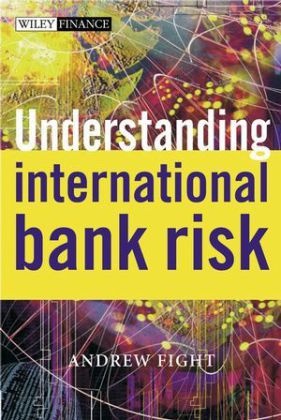Share
Fr. 150.00
a Fight, Andrew Fight, Fight Andrew
Understanding International Bank Risk
English · Hardback
Shipping usually within 1 to 3 weeks (not available at short notice)
Description
Informationen zum Autor ANDREW FIGHT provides financial training and consulting services in the areas of Financial Analysis, Commercial, Syndicated, and Project Finance Lending, Asset Liability Management, Credit Risk Management, and Problem Loan Management. He has over 15 years of experience in international banking and financial analysis gained in Paris and London with Chase Manhattan Bank, IBCA Rating Agency, Euromoney Training, and the French Banker's Training Institute. He is a financial trainer and consultant to several banks, central banks, and IT companies, and a successful author, having written over 15 books on financial analysis, banking risk analysis, credit risk management, credit rating agencies, and information technology in financial services. He divides his time between London, where he works, and his home in the South of France. Klappentext In an era of globalisation, syndicated lending and consolidation within the banking world, virtually all industries will have international dealings, whether directly or indirectly, and will there be exposed to consequential risks. An understanding of international risk, from that of bank or country failure to the idiosyncrasies of different religious, cultural and regulatory frameworks, is essential to the modern banker. This book gives the reader a thorough understanding of how to calculate, analyse and manage such risks.Understanding International Bank Risk addresses the key areas of international risk within the banking environment. It shows the reader how to assess and model both bank and country risk in clear practical terms in order to make informed decisions and be aware of the early warning signs. It spans the full range of factors from the micro to the macro environment and pays particular attention to major growth areas such as syndicated lending."The logical and comprehensive analytical framework makes this a useful guide for credit analysis, particularly in relation to the fundamentals of a bank. Moreover, the frequent tie-ins between theory and empirical information lead to an interesting and easily digestible reading experience."--Suresh Menon, Executive Director, Rating Agency Malaysia Berhad"Risk is the word on the lips of every financial practitioner. Andrew Fight's new book is both a timely introduction to the subject and an excellent survey of risk and risk management in their many manifestations."--Professor Charles W Munn, Chief Executive, The Chartered Institute of Bankers in Scotland, President, The European Bank Training Network, Chairman, QAA Scotland"A challenging and timely review of how to appraise banks, that recognises the wider social context as well as technical analysis. This book will be an important reference point over the next few years as the turbulence of Basel II change increases."--Michael Mainelli, Executive Chairman, Z/Yen Limited Zusammenfassung In an era of globalization, syndicated lending and consolidation within the banking industry, virtually all industries will have international dealings, and will therefore be exposed to consequential risks. This work provides an understanding of how to calculate, analyse, and manage such risks. Inhaltsverzeichnis Foreword ix About the Author xi 1 The Banking Background 1 1.1 Different types of banks and their risk profile 1 1.1.1 Bank failure and the financial services community 1 1.1.2 What do banks do? How do they earn their money? 3 1.1.3 Different types of banks and their revenue structures 6 1.1.4 Commercial banks 7 1.1.5 Investment banks 10 1.1.6 Risk profile of investment banks 13 1.1.7 Broking is a competitive business 13 1.1.8 Derivatives trading and AAA subsidiaries 13 1.1.9 The regulation of investment banks 14 1.1.10 "Analyst of the year" awards 14 1.2 Primary causes of bank failure 16 1.2.1 Types of ...
List of contents
Foreword.
About the Author.
1 The Banking Background.
1.1 Different types of banks and their risk profile.
1.2 Primary causes of bank failure.
1.3 Bank failures - the four aces.
1.4 The macroeconomic environment.
2 The Rating Framework.
2.1 What is a rating?
2.2 The development of ratings.
2.3 Background to rating agencies.
2.4 The rating analytical framework.
2.5 How the rating agencies analyse bank risk.
3 The Regulatory Framework.
3.1 Banking system: structure, governing law, and regulations.
3.2 Core principles for effective banking supervision.
3.3 Risk management.
3.4 Basle Capital Adequacy and international convergence.
4 The Analytical Framework.
4.1 Introduction.
4.2 Financial criteria - the key factors.
4.3 Understanding the bank's balance sheet.
5 Bankscope and Comparative Techniques.
5.1 Bankscope spreadsheet analysis.
5.2 Bankscope ratios and ratio analysis.
5.3 Bank peer group analysis.
5.4 Problems with intercountry comparisons.
6 Country and Political Risk.
6.1 Country risk.
6.2 Political risk.
6.3 Typical sovereign ratings process.
7 The World of E-finance.
7.1 A quick definition of e-finance.
7.2 CRM - Customer Relationship Management.
7.3 STP/CLS.
7.4 SWIFT.
7.5 Electronic funds transfer.
7.6 Online banking.
7.7 Day trading.
7.8 Smart cards.
7.9 Evolution of e-finance.
7.10 Origin of e-finance and internet commerce.
8 Conclusion.
Glossary.
Suggested Readings.
Appendix I.
Appendix II.
Appendix III.
Index.
Product details
| Authors | a Fight, Andrew Fight, Fight Andrew |
| Publisher | Wiley, John and Sons Ltd |
| Languages | English |
| Product format | Hardback |
| Released | 22.12.2003 |
| EAN | 9780470847688 |
| ISBN | 978-0-470-84768-8 |
| No. of pages | 248 |
| Series |
Wiley Finance Wiley Finance The Wiley Finance Series |
| Subjects |
Guides
> Law, job, finance
Social sciences, law, business > Business > Business administration Finanzwirtschaft, Bank, Finance & Investments, Finanz- u. Anlagewesen, Institutionelle Finanzplanung, Institutional & Corporate Finance |
Customer reviews
No reviews have been written for this item yet. Write the first review and be helpful to other users when they decide on a purchase.
Write a review
Thumbs up or thumbs down? Write your own review.

